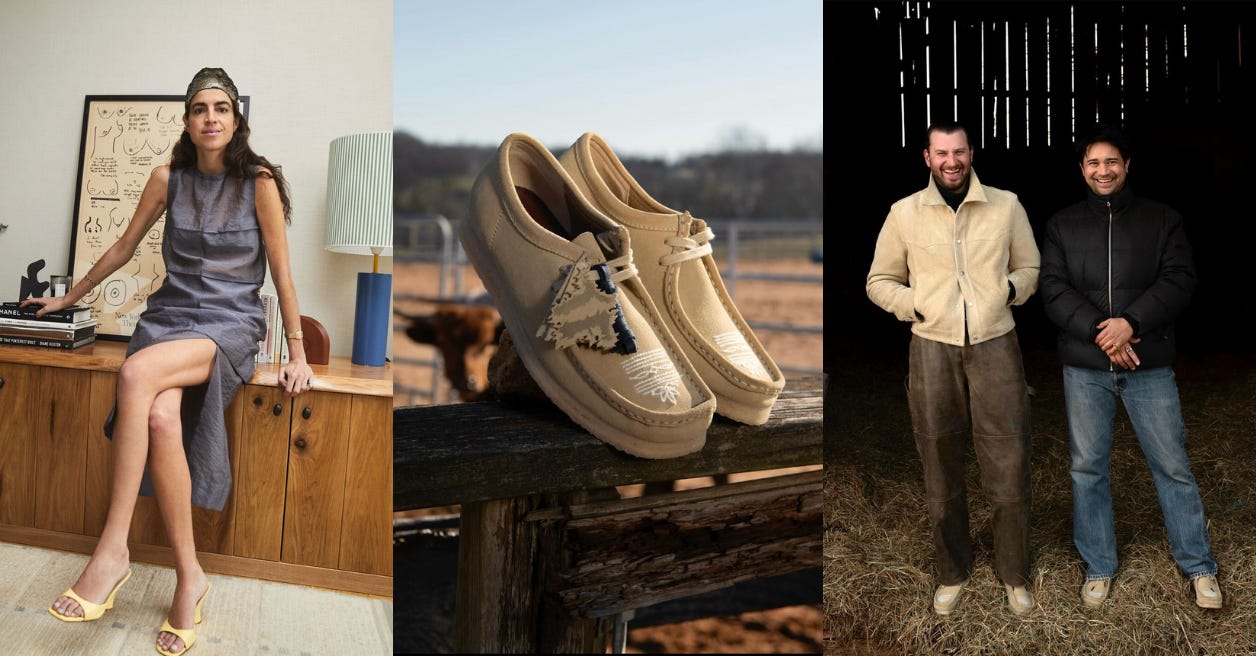Where Brands Meet Print
In-house magazines, sponsored posts, and brands on Substack
Print is fun, romantic even.
Every other beauty, art, and fashion success story starts with someone picking up a magazine when they were twelve. How many people dreamt of being the next Anna Wintour? Amy Astley? Eva Chen? Oh, that slightly chilling yet mesmerizing look of OG editors - you wanted to be just like them!
Every marketer wants to play around with print too. Selfishly, we all want to make something physical, something that lasts, something that says “I am here” a little louder than an IG post — an editorial photoshoot plastered all over downtown, an Iconic Magazines takeover, or at the very least, a branded newspaper stand in the middle of Spring St. We know none of this sells, and yet — we dream.

These days though, I am clinging onto print for a different, less selfish reason. As a media consumer, I find it (and I am using “print” in its broadest, almost metaphorical sense here, meaning everything from certain corners of big media to independent newsletters and blogs) the only safe space I have left. That’s why I am on Substack really. It’s one of the very few types of online entertainment that fills my cup instead of draining it, and doesn’t revolve around getting me to buy stuff….at least, not yet.
Sooner or later though, it will change. The more people join the platform, the less realistic it is for every writer to make a living off paying subscribers alone.
Right now, small, independent media is in an interesting spot. We are seeing independent fashion, beauty, and business writers and publications get the mainstream media recognition partially because big media is in disarray and doesn’t drive the culture like it used to, and partially because social media influencers are starting to lose the plot. There is a whole demographic of women who look to fashion and beauty newsletters more than they look to influencers and media, and anonymous hate essays on Deez Links travel far in the coastal culture discourse. The only hiccup is that right now, Substack is somewhere in between publishing and social, so neither brands nor writers who come up on this platform (as opposed to bringing readers from IG, Twitter, or TikTok) really know how to act yet.
I see a strong reader pushback against the traditional newsletter sponsorship model which is essentially buying up ad space or commissioning a piece. It makes sense, brands are everywhere else on the internet — in between your friend’s photos on IG and in the comment sections of your favorite artists and creators. It’s disappointing to see them infiltrate your inbox alongside the letter from your favorite writers too. Every iconic newsletter of the past, like Girls Night In was practically ruined when it became essentially a sponsored curation of DTC millennial brands.
What I think could be cool and much less invasive is sponsored projects — curated events that live both IRL and in tales from the night in a newsletter, product drops that give writers the tools to create something cooler than drop-shipped merch, and the “little dream” adventures, like going all the way to Texas to watch a total lunar eclipse or a cross-country ice cream tour. I wouldn’t mind seeing brands and writers partner up on a fun read, not an ad read. I want to see writing treated less like a product that could be commissioned and sold, and more like a medium that tells stories about the projects that happen IRL.
I like “Soeur x Cafe Leandra” because it feels like an actual collaboration rather than Souer sticking Leandra’s name on pieces just to get reach. For the same reason, I like the limited drops co-designed by menswear brands and Throwing Fits.
My only wish is that we push the boundaries beyond the fashion writer/fashion podcaster → fashion drop and food writer → recipe collaboration connections into something less obvious, like sending a food blogger dressed in DÔEN on a spontaneous olive tour across Europe (can you tell I am begging for a tour at this point?). Or fine, something less ambitious, like a culture writer, dressed up in Tory Burch, investigating what a fun night looks like somewhere outside of Paris, London, Miami, and New York. A Tory Burch girl should be able to find fun and culture anywhere, including suburban Connecticut and Detroit.
I love a play in the intersection of fashion, hospitality, art, beauty, and food. I love seeing Alison Roman on an Hermes trip to Aspen and diving deep into the state of recommendations, just like a culture writer would. I love seeing Pierce Abernathy on a farm in New York, walking the runway for Helmut Lang, and co-hosting a dinner for hundreds of people in Paris. I am not much of a chef in my own kitchen but I follow both because they are interesting, talented, multi-faceted people.
Does this mean brands should go full editorial and start a Substack though? My heart is telling me yes because selfishly, I’d love to make one work. My gut is telling me…it depends. There were times before social media when blogs is all we really had, and many of them served as a backbone of a growing business. On the other hand, there’s always been a problem with in-house editorial, summarized here by Sophia Neophitou, the editor-in-chief and publisher of 10 Magazine and 10 Men:
The tides have shifted since Acne Paper shut down though. It’s hard to rely on media right now, especially big media — the priorities of their business have changed and for the most part, they are just as much of a big tech prisoner as independent creators are. But what may be the most exciting about building your own media platform right now is loyalty. It doesn’t matter how Apple Podcasts changes its recommendation algorithm — if I like and follow a podcast, I listen to it every week. Letting someone into your inbox is much more intimate than hitting “follow”, and regardless of how Substack is thinking around recommendations changes, your subscribers will keep opening your weekly emails unless you start sending them crap. On social platforms, you’ve got to change your content every time Facebook’s or TikTok’s priorities change to keep your spot in people’s feeds. Publishing doesn’t provide casino numbers, but it is a stable base.
With the rise of the fashion and beauty newsletters, I am really curious to see how fashion and beauty brands get involved. Personally, I wouldn’t mind a brand newsletter — ultimately, brands have the resources to produce higher quality work than independent writers could. We all loved Into The Gloss and it looks like it’s up for a revival, and the Tory Burch team is dipping their toes into Substack with What Should I Wear?
I am convinced that a hit brand newsletter today will look nothing like the OG blogs though. When Into The Gloss was in its prime, there was no other way for us to know that Karlie Kloss washed her face with Clean & Clear (insane btw), but these days, I am not rushing to know what a certain female founder’s or writer’s beauty routine looks like because they already told me all about it on their IG stories or Substack. I am sure it’s a cool, bucket-list feeling to be featured, but ultimately, these posts benefits brands more than they benefit featured guests and the readers.
I’d love to see Tory Burch dress a fun up-and-coming artist whose personality and lifestyle fit into the “Tory girl” brand, and do something lively and chic with her, like scouring family-owned pharmacies for under-the-radar treasures and chatting up the staff. Just like any other creative, I’d die for more “the making of” content about their new store concept or the iconic pieced mule. Tory Burch is a standout fashion brand that’s loved by everyone from cool city girls in their 20s to the fashion industry veterans, and I’d die to catch a little glimpse of the brand magic that made it possible.
The truth is, there are barely any analytics tools on Substack to know how many people buying Ines Slippers came from the newsletter, but a big opportunity to create something that modern city women of all ages are giddy to read. There is a space here to drive culture and start nuanced conversations, and it would be a shame to overlook this in favor of the click-through rate.
IN THE MARGINS:
Here are a couple more things I am thinking about this week:
I wrote about my “personal rebrand” for Things We Don’t Talk About last week! If you’re someone who is afraid to put yourself out there for the sake of your career, give it a read.
This episode of Making Media with Jonathan Becker about paid growth and this episode of Throwing Fits with a buying and merchandising consultant Jesse Judnutt. Having spent so much time in the “rapid growth at all cost” tech bubble, I tend to assess my progress in 2-3 months cycles. It’s refreshing to hear from someone whose work can take anywhere from six months to several years to show any results. Also, insanely interesting that Architectural Digest brought Jesse on for shopping recs (there is much more science to those editorial home curations than I thought).
These notes from Brenda Hashtag from a consulting meeting she had for someone who wants to elevate their personal brand, and this thread about her newly-launched podcast.
This quote from the 1 Granary interview with the founder of Highsnobiety David Fischer about good work:
“Just forget thinking about what could work and what could reach this or that; just do good work,” this is what @mrsnob the founder of @highsnobiety advises his team. It almost sounds idealistic—focusing on high-quality content and hoping it will be appreciated, but in a media landscape where everyone online “hangs out” on niche parts of the internet, it makes sense. Knowing and keeping your audience loyal requires work that is not distracted by a manic chase of reach. The algorithms and the internet’s psychology at large are constantly shifting, making it impossible for human-led platforms to keep up, a phenomenon that has heavily contributed to the media industry chaos of the last decade. But good work that addresses a specific group of people is controllable and ultimately healthier. What leads to high digital numbers is subjective, but “Good, meaningful work that matters,” as Fischer says, can’t be questioned.






i think it's likely that brands will create their own substacks but i'm really not interested in their pov. if i wanted to know more about them, i would have already been subscribed to their newsletters. similarly, founders starting substacks doesnt interest me. they already have a platform, they dont need to commandeer another app. it will be curious to see what happens to substack as the landscape becomes more cluttered
"I want to see writing treated less like a product that could be commissioned and sold, and more like a medium that tells stories about the projects that happen IRL." - this quote will live forever in my mind. Great read!